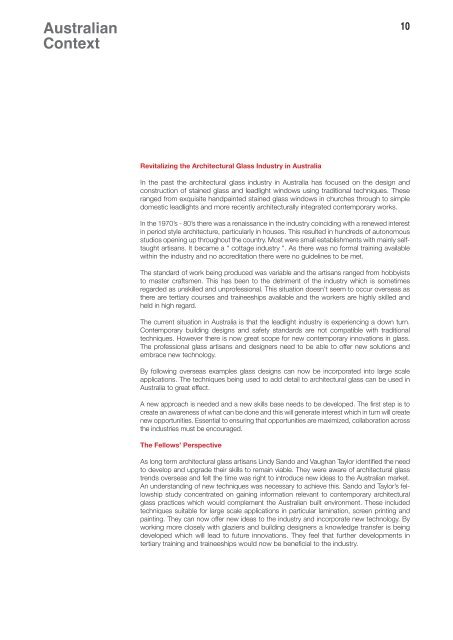contemporary techniques in architectural glass - International ...
contemporary techniques in architectural glass - International ...
contemporary techniques in architectural glass - International ...
Create successful ePaper yourself
Turn your PDF publications into a flip-book with our unique Google optimized e-Paper software.
Australian<br />
Context<br />
10<br />
Revitaliz<strong>in</strong>g the Architectural Glass Industry <strong>in</strong> Australia<br />
In the past the <strong>architectural</strong> <strong>glass</strong> <strong>in</strong>dustry <strong>in</strong> Australia has focused on the design and<br />
construction of sta<strong>in</strong>ed <strong>glass</strong> and leadlight w<strong>in</strong>dows us<strong>in</strong>g traditional <strong>techniques</strong>. These<br />
ranged from exquisite handpa<strong>in</strong>ted sta<strong>in</strong>ed <strong>glass</strong> w<strong>in</strong>dows <strong>in</strong> churches through to simple<br />
domestic leadlights and more recently <strong>architectural</strong>ly <strong>in</strong>tegrated <strong>contemporary</strong> works.<br />
In the 1970’s - 80’s there was a renaissance <strong>in</strong> the <strong>in</strong>dustry co<strong>in</strong>cid<strong>in</strong>g with a renewed <strong>in</strong>terest<br />
<strong>in</strong> period style architecture, particularly <strong>in</strong> houses. This resulted <strong>in</strong> hundreds of autonomous<br />
studios open<strong>in</strong>g up throughout the country. Most were small establishments with ma<strong>in</strong>ly selftaught<br />
artisans. It became a “ cottage <strong>in</strong>dustry “. As there was no formal tra<strong>in</strong><strong>in</strong>g available<br />
with<strong>in</strong> the <strong>in</strong>dustry and no accreditation there were no guidel<strong>in</strong>es to be met.<br />
The standard of work be<strong>in</strong>g produced was variable and the artisans ranged from hobbyists<br />
to master craftsmen. This has been to the detriment of the <strong>in</strong>dustry which is sometimes<br />
regarded as unskilled and unprofessional. This situation doesn’t seem to occur overseas as<br />
there are tertiary courses and tra<strong>in</strong>eeships available and the workers are highly skilled and<br />
held <strong>in</strong> high regard.<br />
The current situation <strong>in</strong> Australia is that the leadlight <strong>in</strong>dustry is experienc<strong>in</strong>g a down turn.<br />
Contemporary build<strong>in</strong>g designs and safety standards are not compatible with traditional<br />
<strong>techniques</strong>. However there is now great scope for new <strong>contemporary</strong> <strong>in</strong>novations <strong>in</strong> <strong>glass</strong>.<br />
The professional <strong>glass</strong> artisans and designers need to be able to offer new solutions and<br />
embrace new technology.<br />
By follow<strong>in</strong>g overseas examples <strong>glass</strong> designs can now be <strong>in</strong>corporated <strong>in</strong>to large scale<br />
applications. The <strong>techniques</strong> be<strong>in</strong>g used to add detail to <strong>architectural</strong> <strong>glass</strong> can be used <strong>in</strong><br />
Australia to great effect.<br />
A new approach is needed and a new skills base needs to be developed. The first step is to<br />
create an awareness of what can be done and this will generate <strong>in</strong>terest which <strong>in</strong> turn will create<br />
new opportunities. Essential to ensur<strong>in</strong>g that opportunities are maximized, collaboration across<br />
the <strong>in</strong>dustries must be encouraged.<br />
The Fellows’ Perspective<br />
As long term <strong>architectural</strong> <strong>glass</strong> artisans L<strong>in</strong>dy Sando and Vaughan Taylor identified the need<br />
to develop and upgrade their skills to rema<strong>in</strong> viable. They were aware of <strong>architectural</strong> <strong>glass</strong><br />
trends overseas and felt the time was right to <strong>in</strong>troduce new ideas to the Australian market.<br />
An understand<strong>in</strong>g of new <strong>techniques</strong> was necessary to achieve this. Sando and Taylor’s fellowship<br />
study concentrated on ga<strong>in</strong><strong>in</strong>g <strong>in</strong>formation relevant to <strong>contemporary</strong> <strong>architectural</strong><br />
<strong>glass</strong> practices which would complement the Australian built environment. These <strong>in</strong>cluded<br />
<strong>techniques</strong> suitable for large scale applications <strong>in</strong> particular lam<strong>in</strong>ation, screen pr<strong>in</strong>t<strong>in</strong>g and<br />
pa<strong>in</strong>t<strong>in</strong>g. They can now offer new ideas to the <strong>in</strong>dustry and <strong>in</strong>corporate new technology. By<br />
work<strong>in</strong>g more closely with glaziers and build<strong>in</strong>g designers a knowledge transfer is be<strong>in</strong>g<br />
developed which will lead to future <strong>in</strong>novations. They feel that further developments <strong>in</strong><br />
tertiary tra<strong>in</strong><strong>in</strong>g and tra<strong>in</strong>eeships would now be beneficial to the <strong>in</strong>dustry.

















